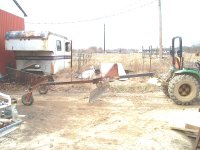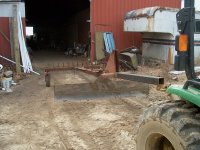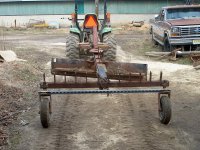Maybe I posted the wrong link, the grader I was mentioning is rated for up to 150 hp, the 5245 mfwd is 50 hp isn't it?
Yes, its originally 50 hp, opened up a bit (but never dynoed) but because its weight and traction, it will do the job of an 80 hp, just in a lower gear... i have bad experience with light duty equipment.
the blade would slie the whole implement over then I backed it a bac into the shop and ground off the tacks and bolted the combines steering cyliner back into place. When grading and angleing the blade you could steer opposite of the leading aedge of the blade sort of like the way a graders wheel lean works.
Now you have my full attention: i have already foreseen that problem, and also thought of the solution to it: You just tell you've been there, done that.
How much offset did you do with the steering wheels in order to keep the grader from sliding ? Did it pull the rear end of the tractor aside when pulling in offset ?
I wanted the 3pt hitch setup so both the front and the rear axle would take up the side force of the blade, and the offset function would equal the forces of the angled blade.
You're right, the pull type might be even simpler, and with steering rear wheels just as manoueverable as the 3pt unit (which, if you have a fixed axle, will make it hard to steer the tractor, and if you make them caster, will give no extra resistance to keep the angled blade going straight.
Please tell me everything about this !
If you build the unit and use rear wheels that are steerable, you could move around fence post, left and right, and not change your blade height.....
....copy the hydraulic tilt shown and you would have gotten most of what you want with out multiple hydraulic circuits and expensive pivots.
i agree, a steered rear axle is the cheap ticket to move around trees and clear ridges under a horse fence.. when using a rigid axle with central pivot steering (like a hay trailer) It can be steered at standstill with little resistance nor friction.
On the other hand, a dual pivot conventional axle (fist axle) can be mounted in such order that the wheels lean "against" the blade by using a very agressive caster angle, something like 30ー kingpin inclination. When done right, the wheels lean into the corner when steering. all cars have this for steering stability and better tire grip when cornering, but i think i will have a good effect if i increase caster from 5 or 7 degrees, to 30 degrees.



